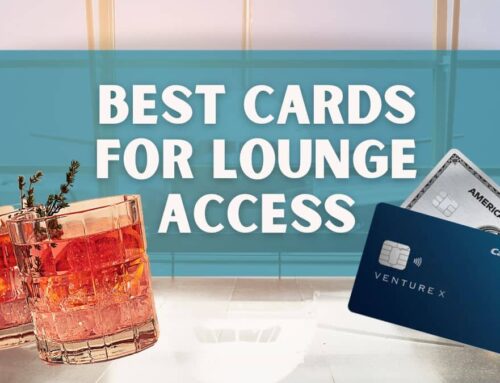Introduction to Travel Points
What are travel points cards?
We are specifically referring to leveraging miles and points to offset or cover travel costs.
The basic idea is this:
- Open credit cards that reward you with bonus points after you spend a certain amount of money.
- Meet the minimum spending requirements in the allotted timeframe to get the points.
- Redeem your miles and points for travel.
- Repeat this process to accumulate more and more miles and points.
Of course, travel points is a lot more complicated than simply opening cards and taking trips. That’s why we’re here! Our goal is to help you earn and redeem points for travel in a way that doesn’t leave you feeling overwhelmed.
Are travel points for me?
Travel points can be helpful in offsetting travel expenses, regardless of your travel goals. Whether you travel alone or with your family, travel once a year or are looking to take a gap year, or whether you fly basic economy or business class – you can use miles and points to help you achieve your travel goals. The options are endless!
That said, travel points cards is not for everybody.
First of all, the deals we discuss here are mainly applicable for United States residents. There are other blogs that dive into deals for Canadians or Europeans, but this isn’t an area we cover here.
There are three essential rules to follow. If you aren’t able to follow these rules, then travel points cards are not for you.
Rule 1: Have a good credit score
You have to have a good credit score to access these deals. Usually that means a score of at least 750. If your score is lower you’ll want to work on building your score first.
If you already have good credit, you may be worried this will ruin your credit scores. It won’t. See our post on credit scores to learn how this hobby can actually increase your credit score.
Rule 2: Pay your bills on time and in full each month
Banks make a lot of money on credit cards when people carry a balance. Nearly all of these travel cards have astronomical interest rates— usually 18% or higher. If you carry a balance, you will quickly negate any value from the miles you’re earning.
If you carry a balance on any of these cards, the banks have “won.” Wait until you can reliably manage your monthly spending before you proceed. This is not about spending more money on credit cards. It’s about leveraging your regular monthly spending in such a way that you get more points. Use your regular spending to meet your minimum spending requirements and enjoy the benefits of the points you’ve earned.
Rule 3: Stay organized
You need to track the cards you are opening as well as the points you are earning. Read our post on organizing your travel points and cards to learn more about how to stay organized.
What are miles and points?
Miles and points are the “currency” that banks, airlines, and hotels use to reward customers for their loyalty. More specifically, when we use the term “miles and points” we are referring to bank rewards, airline frequent flyer miles, and hotel points.
If you earn miles and points the traditional way, you earn them based on spending. You take a flight on United Airlines and earn United miles based on how much that flight cost. You stay a night at the Marriott and earn Marriott Bonvoy points based on how much that night cost.
If you have an airline or hotel co-branded credit card, you will also earn points whenever you use that card.
You can earn free travel this way, but for most people it’s going to take a long time to accumulate a substantial amount.
How can I earn a lot of points?
That’s where travel cards comes in. Our goal is to earn extra points by taking advantage of bonuses — particularly credit card bonuses. These are the extra points that credit cards offer to incentivize you to open and spend on their card. It’s not uncommon for credit card bonuses on a low fee (under $100 per year) card to be 60,000-80,000 points.
After you have been approved for a card you will need to meet the minimum spending requirement in the time frame allotted in order to receive your bonus.
Types of travel credit cards
It’s helpful to understand the different kinds of cards that are offered by banks.
In general, these three different kinds of credit cards are the most helping for paying for travel. We often use the terms “miles” and “points” interchangeably on this blog.
1. Airline cards, which give you miles and points on a specific airline
2. Hotel cards, which give you points to a specific hotel brand
3. Flexible travel cards, which is the most complicated category, but also the most powerful. Some cards will reimburse travel expenses using points. Some allow you to use points to book airfare and hotels. Some also allow you to transfer points to hotels or airlines. This includes points programs like Chase Ultimate Rewards®, Citi ThankYou® Points, American Express Membership Rewards®, as well as cards that earn the Capital One Venture miles.
There are also cards that exclusively earn cash back or that are affiliated with almost every major store, but we generally don’t delve into those here.
Airline cards
Most airlines have partnerships with banks that issue a co-branded credit card. For example, a Chase United℠ Explorer card is a partnership between Chase Bank and United Airlines. When you spend money and earn bonuses on these cards, you will earn airline miles. These miles can in turn be used with the airline on the card.
Hotel cards
Hotel chains also partner with banks to issue co-branded credit cards. When you spend money and earn bonuses on these cards, you earn hotel points. These points can then be redeemed for hotel nights with the hotel on the card.
Flexible travel cards
Rewards earned through flexible travel cards or transferrable points cards can be used in a variety of ways. Most commonly rewards are redeemed through the bank’s travel portal or through transferring rewards to bank transfer partners.
These are often some of the best cards to start with because they have so many options.
Examples of cards with flexible points include a card like the Chase Sapphire Preferred® Card.
What’s a Travel Portal?
With flexible points, most banks offer the option of booking travel through their own portal. These portals operate like Expedia or Orbitz, essentially they are an online travel agent. Redeeming rewards through a travel portal is fairly straightforward. Banks will assign a value to your points (typically 1-1.5 cents per point) and when you find a booking you want in the portal – airline, hotel, car rental, etc – then you can choose to apply your points to offset all or part of the cost.
Booking through a travel portal can have higher earning rates, too. If you have a Capital One Venture X Rewards Credit Card, for instance, any rental car or hotel booked through Capital One Travel will earn you 10 miles per dollar.
The secret to unlocking value: transfer partners
Transfer partners are airlines and hotels that have partnered with a bank so that you can move your rewards into their loyalty program. Each bank has a different set of transfer partners.
Transferring rewards to transfer partners is also pretty straightforward (though leveraging your transferred miles and points to maximize their value can be complex). When you earn rewards through credit card spend and bonuses, you will be able to log into your credit card account and choose to transfer your rewards to a transfer partner’s loyalty program.
Transfers are often instantaneous and then you can use those miles or points to book hotels or flights directly through the loyalty program. For example, if you have Chase Ultimate Rewards® and transfer those to Southwest Airlines, you will now have Southwest Rapid Rewards that you will immediately be able to use to make an award booking.
Rewards typically transfer at a 1:1 ratio (so 1,000 Chase Ultimate Rewards® will become 1,000 Southwest Rapid Rewards), but there are some exceptions. Sign up below to receive our transfer partner guide to see where and how to transfer points from your favorite flexible rewards card to a transfer partner.
How can frequent flyer miles and hotel points be used?
When you have a co-branded card, those miles and points are deposited directly into your loyalty program account. They can generally only be redeemed through that loyalty program.
Similarly, if you transfer flexible rewards into a loyalty program, they can now only be redeemed through that loyalty program.
Hotel points are redeemed for hotel nights at the respective hotel chain.
Frequent flyer miles are redeemed for flights booked through the airline loyalty program. Flights are booked through the airline you have miles with, but they don’t necessarily need to be on that airline since many airlines are part of airline alliances. This is where travel points redemptions gets more complicated. But again, this is where you can unlock more value.
Airline Alliances
Since this is Travel Points 101, I’m not going to go into all the complexities of airline award bookings and maximizing redemptions. But I do want to touch on airline alliances and give an overview of how these work and why these can offer the best value for your points.
Airline alliances are partnerships between airlines worldwide. Most of the major airline carriers are part of one of three alliances: Star Alliance, One World, or Sky Team.
Airlines within an alliance may share flights, sell flights on a partner airline, and allow bookings across airlines within the alliance.
Not only can you book cash flights with Alliance members, but you can also book award flights with Alliance members. Availability is limited and not all flights and routes are available for partner bookings.
Because each airline sets its own reward charts, it can be advantageous to transfer your reward points to one airline (for example, Turkish Airlines) with the intention of booking a flight on another airline (for example, United Airlines) because the redemption value is better. You may be able to take the exact same flight for fewer points. You can read our how-to that covers this exact scenario to better understand transfer partners and how this works.
Ready to get started?
If you haven’t taken the leap and opened a travel card yet, check out our post on picking your first card to get started earning points. Otherwise, browse the best current offers to pick your next card. When you sign up for a card using our affiliate links, you are helping us keep our content free.
Responses are not provided or commissioned by the bank advertiser. Responses have not been reviewed, approved or otherwise endorsed by the bank advertiser. It is not the bank advertiser’s responsibility to ensure all posts and/or questions are answered.






